Montegabbione
La Storia siamo noi, nessuno si senta escluso...
![]() Disponibile in italiano: clicca qui.
Disponibile in italiano: clicca qui.
June 16, 1944: the battle of Montegabbione
June 16, 1944 was a Friday, finally a beautiful sunny morning after a substantial period of rainy weather.
The rapid advance of the Allies after the fall of Rome on June 4, had now come to us; on June 14 Orvieto had been freed without fighting, thanks to an agreement, sponsored by Bishop Francesco Pieri, between the German commander, Lieutenant Colonel Alfred Lersen, and the British.

[1] vintage wirephoto - British Sherman tank in Orvieto, June 14, 1944
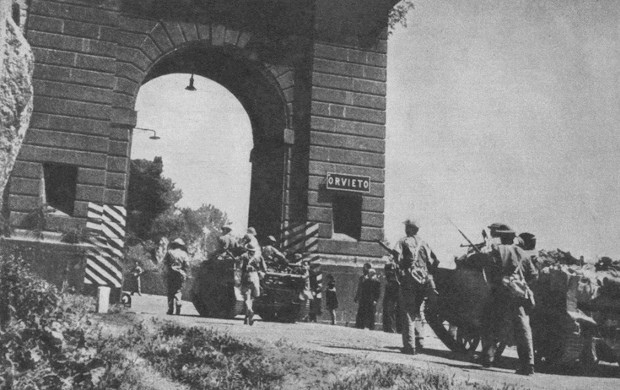
[2] entrance of the British in Orvieto, June 14, 1944
The next day, on 15, the German garrison of Ficulle had fallen after a fierce battle: two British M4 Sherman tanks, those in the top of the column coming down from Mount Nibbio from Orvieto, were still in flames a hundred meters before the cemetery and would remain there long, buried in a corn field, before being recovered only several years later.
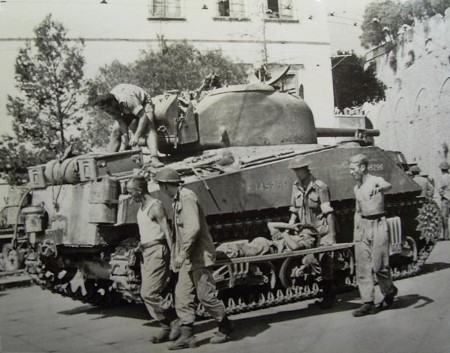
[3] vintage wirephoto - giving help to a wounded British soldier, near a Sherman tank
The stationmaster of Carnaiola Scalo (that was the current railway station of Fabro), who lived midway between Faiolo and Montegabbione, breathless brought news of the imminent arrival of the Allies, coming from Fabro; the inhabitants of the houses outside the medieval walls concentrated mostly in the bomb shelter that was within the village, others preferred to hide in basements or in the countryside.
Unfortunately, in our own zone, and the battle of Ficulle the day before had been already a sign, the Germans were poised to resume strong opposition to the Allied advance, which until then had been unexpectedly rather fast up from Rome, to prepare a defensive line attested to the height of Lake Trasimeno (precisely the Trasimeno Line) and stand on it for as long as possible, to allow time to adequately prepare a more solid defensive line in the Apennines (the notorious Gothic Line) and strand there the Allied advance, possibly permanently, during the following winter.
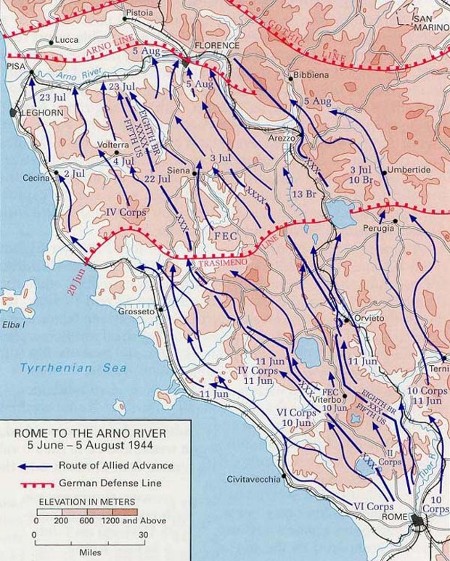
[4] Allied advance from Rome to Arno river, from June 5 to August 5, 1944
British historian Richard Doherty (in "Eighth Army in Italy 1943-45 The Long Hard Slog", pp.120-121) writes:
"
Alexander's pursuit of the the enemy was, thus far, going as planned but there were already signs that the Germans were preparing to hold their latest defensive positions. Although the main portion of 78th Division was midway twixt Rome and Florence it was about to be delayed by the enemy.
"
And the historian Cyril Ray (in "Algiers to Austria. The History of 78 Division 1942-1946", pp.143-145) adds:
"
On June 15, 11 Brigade had passed through the Irish Brigade, crossed the River Paglia, and continued the advance. By this time the forward troops of the Division were a hundred miles north of Rome and half-way to Florence. But it could not be expected to go on at this rate. The Germans were bound to make some sort of a stand before we approached Florence so as to delay us, cause what damage they could, and save as much of their own armies as possible.
"

[5] German Tiger tank in the column near Orvieto, visible in the background
Well, during this change of strategy, the front line reached our country; Doherty's story (cit.) continues in this way:
"
Eleven Brigade crossed the Paglia river on 15 June, the day before 5th Northamptons, supported by the Wiltshire Yeomanry, divisional artillery and 1st Kensingtons' 4.2-inch mortars, attacked Monte Gabbione, some ten miles from Lake Trasimene's southern shore.
Against stiff opposition the Northamptons pressed home their attack which the divisional historian described as 'one of the best actions ever fought by the battalion'. The attack showed considerable skill on the part of the Northamptons' officers, especially the junior officers.
When the leading company -A- met heavy rifle fire the company commander left one platoon behind to provide fire support while the other two were directed on the school and a large building to its right. Both objectives were taken although the victors were subjected to several hours of fierce fire from nearby buildings.
C Company also fought its way into the town and S Company's commander directed fire from Wiltshire Shermans on to buildings still occupied by the enemy.
Unusually, there were no counter-attacks. The Germans pulled out during the night leaving the Northamptons in possession.
"
The big building to the right of the school (seen from the south, which was the direction from which came the attack) was the palace of Alfonso Giulietti. Indeed, this one and the school were the two biggest buildings in a strategic position close to the walls of the old town, which was firmly occupied by the Germans. In the photo below, more or less going back to that period, in which the buildings in question are highlighted, we see that the slopes of the country were obviously much less built-up than today, and consisted mainly of land divided into tiers, built with drywalls.
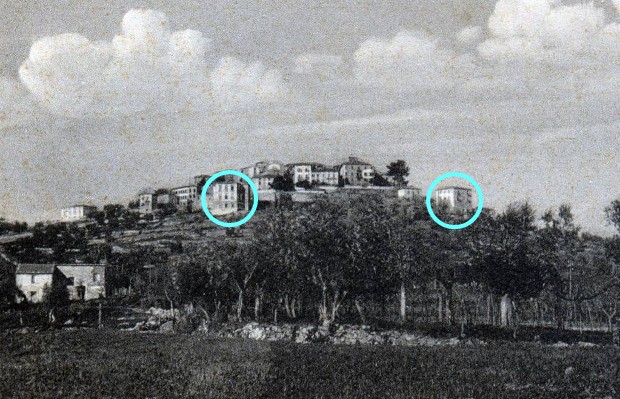
[6] 40's Montegabbione postcard looking North
Some of these drywalls, which became a shelter for British soldiers of the 5th Northamptons which that June 16 laboriously conquered the village, are still there, and for many years after the war continued to return the signs of the battle consisting of shells, unexploded projectiles and grenades that some kids, as our Corrado Rossi tells us, painstakingly gathered and brought to the Carabinieri, pecking regularly stern rebuke...
From other vintage postcards we understand the appearance of the slopes of the hill, scene of the battle of Montegabbione; here are a few, from the collection of Daniele Piselli.
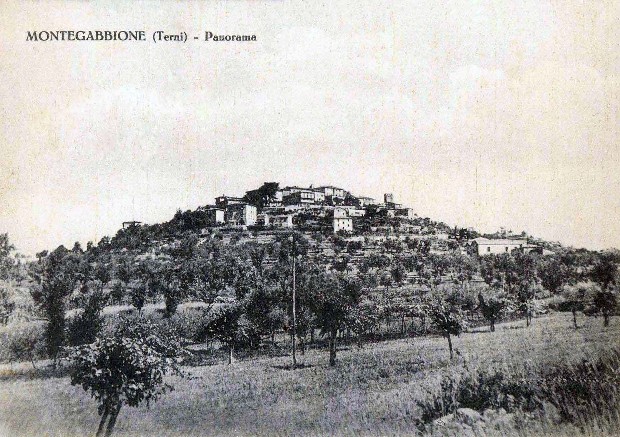
[7] Montegabbione postcard looking North
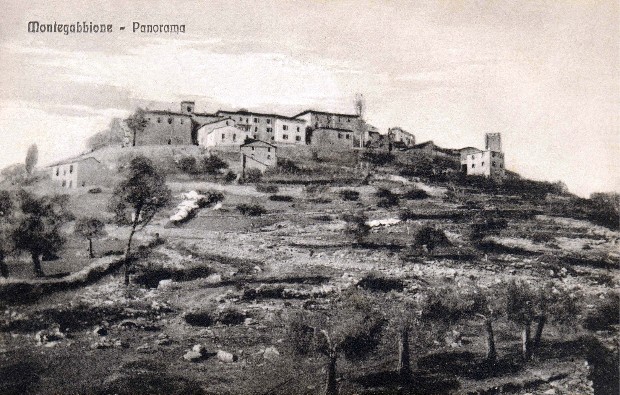
[8] Montegabbione postcard looking West
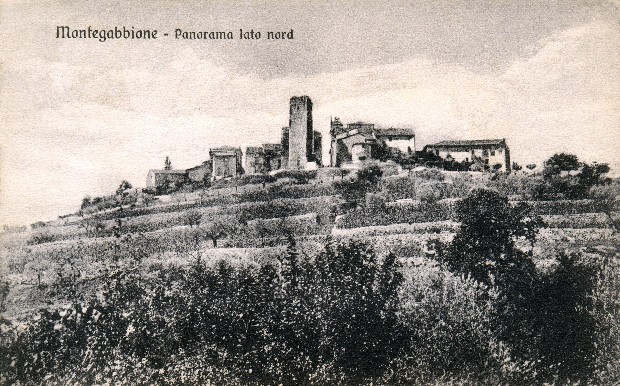
[9] Montegabbione postcard looking South
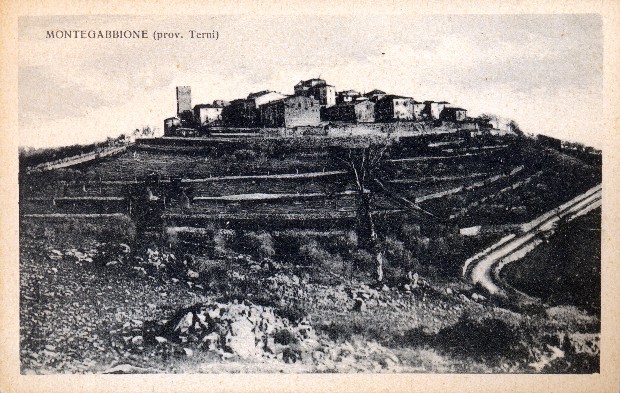
[10] Montegabbione postcard looking East
Cyril Ray (cit.) adds details to the story of the battle of Montegabbione:
"
At midday on June 16 the Northamptons launched an attack on Monte Gabbione, mid-way between Orvieto and Lake Trasimene, supported by artillery, by the Wiltshire Yeomanry, and support-group mortars. They met stiff opposition and the capture of this little town proved to be one of the best actions ever fought by the battalion.
The town stood on a hill and completely overlooked our approach. The battalion formed up in a wood – the country was close and co-operation with tanks therefore difficult. After an initial concentration 'A' company, whose task it was to capture the town, advanced. The first 2,000 yards were simple, under the cover of the trees, but as soon as they reached the open they were greeted with volleys of rifle fire.
8 platoon, led by Lt. Terry, advanced to the school, one of the key points of the town, whilst 9 platoon, led by Lt. Pulleyn, soon to be wounded in both arms, advanced to a large building on the right and 7 platoon remained below as fire platoon. After a brief skirmish the school and the building were taken; and the platoons were joined by Company Headquarters in the school where for several hours they were under rifle and machine-gun fire from houses opposite.
Meanwhile, 'C' company, led by Major Newby, had entered the town and the men of 7 platoon, occupying a house near by, had to leap thirty feet from the veranda, one by one, when the building went up in flames.
Major Crocker, of 'S' company making his way back to battalion headquarters, below the town, was led by the padre, Captain Elworthy, and was able to direct the fire from the Wiltshires’ tanks on to the points still in enemy hands. The expected counter-attack never came, and when 'C' company entered the town next morning they found the enemy had withdrawn during the night.
"
The 5th Northamptons cited in the text was the 5th Infantry Regiment Northamptonshire. The 'A' Company, who led the attack, was composed of 3 Platoons: the 7th, the 8th and 9th. In general, each Company could be composed of 3, 4 or 5 Platoons. Each Platoon, divided in turn into 2, 3 or 4 teams, typically comprised of about 40 soldiers (30 to 50) and was typically commanded by a Lieutenant ( 'Lt.' in the text).
The 3 Infantry Companies mentioned in the chronicle of the attack were probably made up of 3 Platoons each, for a total of over 800 soldiers; these forces were supported by the divisional artillery, a mortars group, and the regiment of tanks.
The German forces occupying the village were formed instead, how it appears from informations provided to the British by the inhabitants of Montegabbione aftermath of the battle, by about 200 men.
The following is a detail taken from a topographical map built right in 1944, on which we highlighted in red the two buildings mentioned in the chronicle of the battle; it can be seen that only a few houses stood on the slopes of the hill.
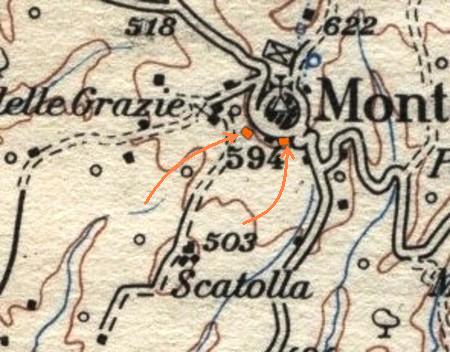
[11] the two buildings cited in the chronicle of the battle, on a 1944 map
In the map you can also see the Scatolla area, that is where the British troops concentrated before the attack, protected from the bush. Moreover, the same forest that prevented the Germans holed up in the center of Montegabbione to spot and hit the British also constituted an obstacle for them in the coordination of the advancing infantry protected by the Sherman tanks; some inhabitants of Montegabbione still remember the explorers, on board Shermans, looking for a path through the woods, cutting down without ceremony the trees that were in the way, then maybe having to go back, once established that there was no way to pass because it ended in a ditch...
And here is the same area as the previous map in a satellite photo of our day; from a comparison with maps of land use in the early 50's we see that the extension of the forest around Scatolla is similar to that of 1944.
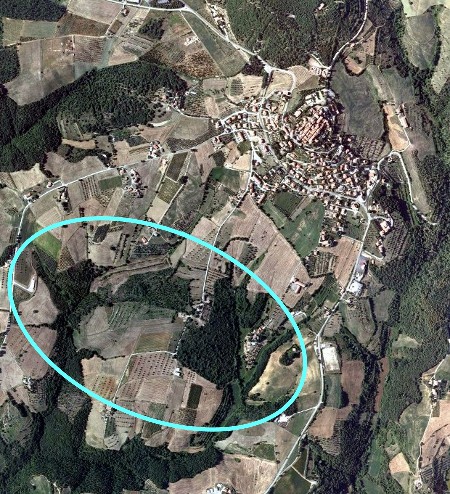
[12] satellite photo corresponding to the 1944 map
From the edge of the forest to the slopes around the village clearly everything became much more difficult, because once in open field the British were made the subject of intense fire by the Germans; at this juncture proved very effective the fire of the guns of Sherman tanks, strategically placed in the plain, against the buildings of the historical center from which the Germans were firing, on the recommendation of the advancing British infantry.
Some inhabitants of Montegabbione recall the effect of this cannonade; to our Enrico Ciurnelli has been well impressed the image of Via Roma, in the aftermath of the battle, completely littered with rubble...
Traces of these shots are also imprinted in the town's medieval walls; a plaque placed by the municipality highlights one of them on the southwest side of the town, on the side facing the school, not coincidentally key point of the battle.
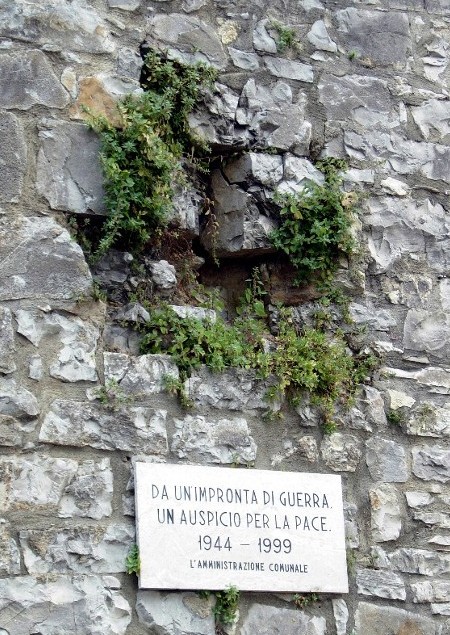
[13] a shell sign on the south-west of the medieval walls of the town
Indeed, the type and extent of the damage appears more compatible with the 75 mm cannon of a Sherman tank from a few hundred meters than with large-caliber artillery shells which also came from Mount Nibbio. For others, it could be the effect of a British hand grenade.
About the tanks, the group of M4 Shermans in support of the 5th Northamptonshire Infantry Regiment in the attack on Montegabbione belonged to the Royal Wiltshire Yeomanry, which belonged, along with two other regiments of tanks (the 3rd Hussars and the Warwickshire Yeomanry) and the 1st King's Royal Rifle Corps, to the 9th Armored Brigade.
The symbol of the 9th Armored Brigade was a white horse in a green square. The three regiments of tanks belonging to the brigade were identified by red signs for the 3rd Hussars, blue signs for Warwickshire Yeomanry and yellow signs for the Wiltshire Yeomanry (the latter involved in the attack on Montegabbione).
 [14] the insignia of the 9th Armoured Brigade
[14] the insignia of the 9th Armoured Brigade
In each of these three regiments, the triangular banners identified the 'A' Troop, the square ones the 'B' Troop and those round the 'C' Troop; the headquarters ('HQ') of the regiment was identified with a diamond.
In another source, "The Royal Wiltshire Yeomanry 1907 - 1967" by JRI Platt, we find that Lieutenant Colonel Lloyd, in command of the Regiment of the Royal Wiltshire Yeomanry, sent in support of infantry in the Battle of Montegabbione half of 'B' Squadron, under the command of Major Christie-Miller.
As seen, the Sherman tanks of 'B' Squadron had yellow squares as signs; I wonder if some of our fellow citizens recall having noticed...
The intervention of the Wiltshire Yeomanry tanks occurred in a coordinated manner on three objectives: Montegabbione, Monteleone and Citta della Pieve. Platt writes (cit., P.168-169):
"
The roads were littered with debris left by the retreating Germans; burnt out vehicles and tanks and charred and broken equipment everywhere, clear evidence of the devastating effects of Allied air attacks.
Meanwhile 13 Corps was now astride the River Tiber with 6th (British) Armored Division east of the river and 6th South African Armoured Division and 78th Division on the west. Between the 9th and 15th the advance continued with the Regiment still in reserve.
On the 16th it was required to take part once more in the fighting. It moved off at 5 a.m. behind the 3rd Hussars and Lieut. Colonel Lloyd sent half 'B' Squadron under Major Christie-Miller with 11th Brigade in an attack on Monte Gabbione midway between Orvieto and Lake Trasimene. The town was captured by the Northamptons after a spirited attack.
Meanwhile the remainder of the Regiment made contact with the enemy north of Monteleone where a fierce action was fought in which four enemy anti-tank guns were knocked out for the loss of four tanks. In this action Sergeant Woodman was awarded the Military Medal. There was heavy shelling by the enemy just as 'A' Echelon was moving off and the C.O.'s caravan received a direct hit. Driver Chittock was killed and all Lieut. Colonel Lloyd's kit destroyed.
On the 17th the Regiment took over from the 3rd Hussars in front of Citta Della Pieve, but was unable to force a way into the town which was strongly held.
On the 18th the attack was resumed with 'C' Squadron in the lead and half 'A' Squadron under Captain Bell attempting a right flanking movement. They were hampered by demolitions and progress was slow. There was heavy mortar fire and Lieutenant Wareham, the 'Rear Link' Officer, was wounded. In the evening HQ 78th Division intercepted an enemy wireless message giving the time of their withdrawal. At that time plus five minutes the whole divisional artillery plastered the exits from the town for two minutes. Next morning the Buffs, taking over from the East Surreys, found the outskirts littered with the bodies of German soldiers.
Citta della Pieve, defended for several days by 100 fanatical paratroopers, had seriously held up the advance of the division.
During these operations casualties amounted to two soldiers killed, and one officer and eleven soldiers wounded. The deal included Lance Corporal Mount M.M., killed while driving the medical truck, clearly marked on each side with a large Red Cross, into Citta della Pieve.
The Brigade had advanced a total of fifty miles since leaving Alatri. After the capture of Citta della Pieve the advance continued over rugged country towards Vaiano...
"
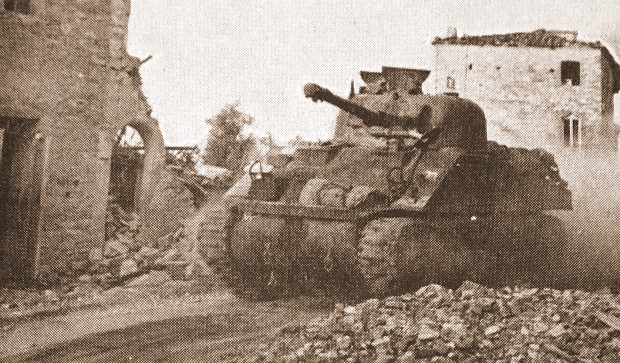
[15] an M4 Sherman tank in Castiglione del Lago, in June 1944
From the typical composition of a British Squadron in June 1944 in Italy, one can infer that the Sherman tank directly involved in the battle of Montegabbione, in support of the 5th Northamptons, were about 10 in overall; a total of about 60 tanks were involved from 16 to 18 June 1944 for the liberation, in rapid succession, of Montegabbione, Monteleone and Citta della Pieve.
Returning to the story of the 5th Northamptons battle, we read that after the storming of the school and the Giulietti building, the men of the 7th Platoon left so crazy a burning house near the school, by jumping one at a time from a balcony, about nine meters in height (30 feet), from the side of the building facing Monteleone.
It was there that he died, shot by a sniper, John Granville Warner (called Jack), a young soldier, identification number 14331593, now resting in the Orvieto War Cemetery (position I, B, 15) in the second row, alongside fellows died that day in the battle of Montegabbione... but to their identity and their stories will be soon devoted a separate page; a British researcher, in fact, will send documents in this regard.
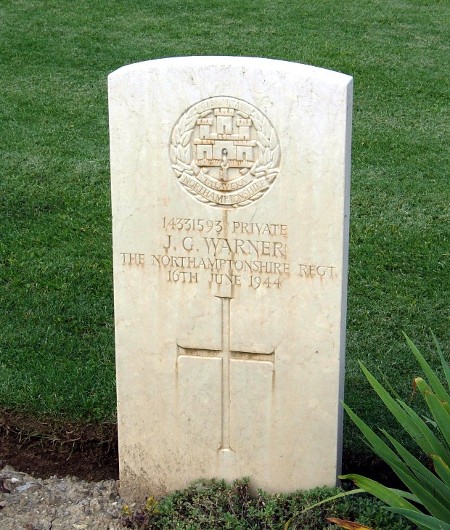
[16] Jack Warner's grave, Orvieto War Cemetery
We must remember that John Dray, a fellow of Jack Warner luckily survived that day in the house on fire, returned 60 years later, in May 2004, to visit the tomb of his friend and the site of the battle here at Montegabbione. You can find here the story of his visit, even with a photo next to our Eva Saravalle.
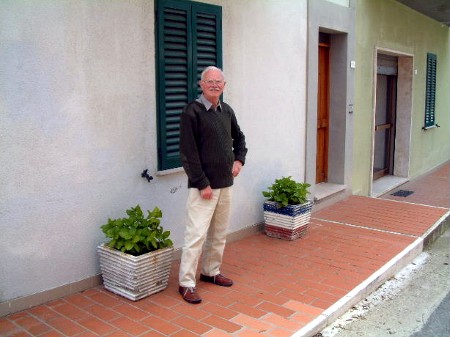
[17] John Dray in front of the house believed to be the one burning on June 16, 1944
John Dray has published on the Web this photo, in which he can be seen in front of the Barlozzini house beside the old gas station in the village; in the memories of the old soldier, this is the house that was engulfed in flames on the day of battle.
In fact, Andrea Barlozzini tells us that, according to what his grandparents were reporting, and confirmed by his father, the house that was burned in front of schools during the battle is not that one given by the veteran, but is that one where currently the medical practice and the pharmacy are; it cannot be the home of his grandparents because at the time there was not yet a home, but only a garage.
For clarity, here is a recent aerial photo where we show the places mentioned in the text:
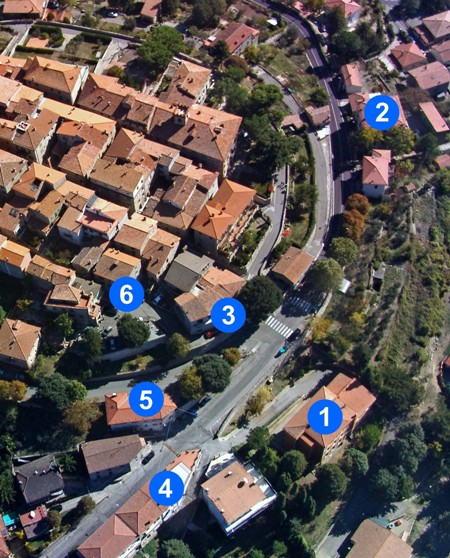
[18] aerial photo showing the places mentioned in the text
(1) The school, conquered by the 8th Platoon of "A" Company;
(2) Giulietti palace, conquered by the 9th Platoon of "A" Company;
(3) Grenade (or Sherman gun) shot against the walls of the village;
(4) Barlozzini palace, in front of which the photograph with John Dray was taken;
(5) The current medical practice, hit by the German Panzergrenadiers during the Battle of 16 June;
(6) Position presumably occupied by Panzergrenadiers firing at the building (5).
It's astonishing to think that, after so many years, here and there signs of that battle are still found, taking the form of an old book, an old picture, the story of one of our fellow townsman, the visit of an elderly veteran, or even some old object. Did you know that after many years the ground of the village has given back some British helmet?
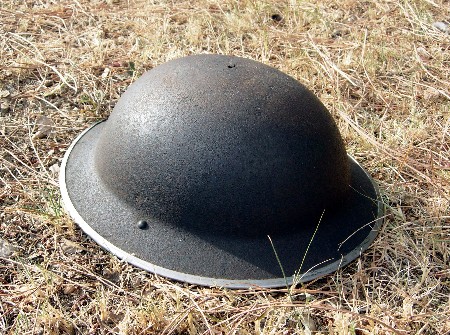
[19] 1944 British helmet, from excavations
Other documents are coming soon, and we are collecting more testimonials from our neighbors, and soon this section will be enriched by new information!
Fabio Roncella
References
- Doherty, Richard, "Eighth Army in Italy 1943-45 The Long Hard Slog", Barnsley, Pen & Sword Military, 2007.
- Ray, Cyril, "Algiers to Austria. The History of 78 Division 1942-1946", Eyre & Spottiswoode, London, 1952.
- Platt, J.R.I. "the Royal Wiltshire Yeomanry 1907 - 1967", Garnstone Press, London, 1972.
- The National Archives - London.
pictures:
[1] http://www.sandrobassetti.it/sferracavallo/storia.htm.
[2] 1944 wirephoto - private collection.
[3] 1944 wirephoto - private collection.
[4] US Army Center of Military History - http://www.history.army.mil/.
[5] http://www.sandrobassetti.it/sferracavallo/storia.htm.
[6],[7],[8],[9],[10] postcard from the private collection of Daniele Piselli.
[11] 1944 military map - private collection.
[12] recent satellite photo - Pagine Gialle Web.
[13] author's photo.
[14] public domain.
[15] Platt, J.R.I., cit.
[16] author's photo.
[17] http://battlefieldsww2.50megs.com/italy_diary_2004.htm.
[18] aerial photo by a friend from Montegabbione.
[19] author's photo.
Logo picture by Guido Urbani.